This page describes various cluster networking options that can be configured for each KKP user cluster either via KKP UI (as shown below), or via KKP API.
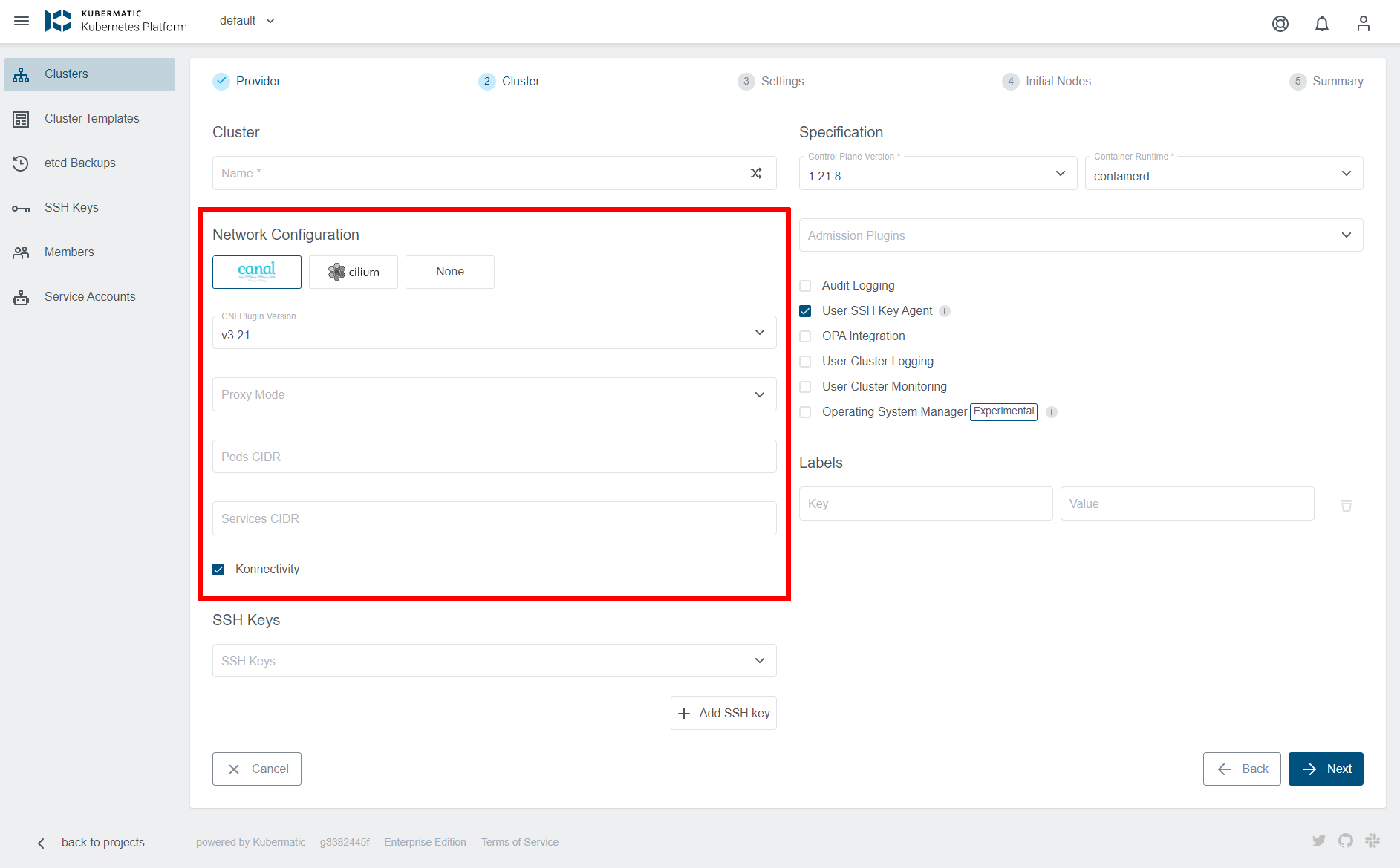
CNI Type and Version
KKP supports three types of CNI (Container Network Interface) plugin types:
The following table lists the versions of individual CNIs supported by KKP:
| KKP version | Canal | Cilium |
|---|---|---|
v2.19.x | v3.21, v3.20, v3.19, (deprecated: v3.8) | v1.11 |
v2.18.x | v3.19 (deprecated: v3.8) | - |
v2.17.x | v3.8 | - |
Note: The deprecated versions cannot be used for new KKP user clusters, but are supported for backward compatibility of existing clusters.
The desired CNI type and version can be selected at the cluster creation time - on the Cluster Settings page, as shown below:
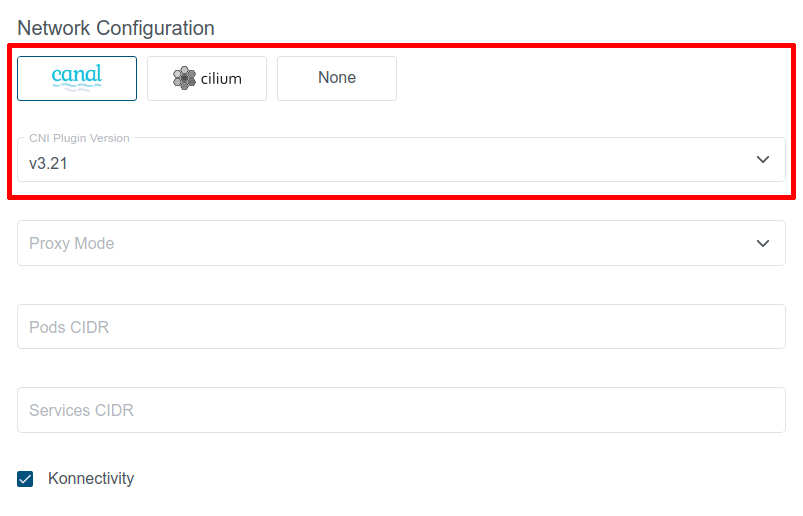
Available CNI versions depend on the KKP version. Note that CNI type cannot be changed after cluster creation, but manual CNI migration is possible when necessary.
Canal CNI
Canal is a combination of Flannel CNI and Calico CNI, which sets up Flannel to manage pod networking and Calico to handle policy management. It is a CNI that works fine in most environments but may not be sufficient for some large scale use-cases.
In KKP versions below v2.19, this was the only supported CNI.
Cilium CNI
Cilium](https://cilium.io/) is a feature-rich CNI plugin, which leverages the revolutionary eBPF Kernel technology. It provides enhanced security and observability features, but requires more recent kernel versions on the worker nodes (see Cilium System Requirements).
Before opting for Cilium CNI, please verify that your worker nodes’ Linux distributions is known to work well with Cilium based on the Linux Distribution Compatibility List.
The most of the Cilium CNI features can be utilized when the ebpf Proxy Mode is used (Cilium kube-proxy-replacement is enabled). This can be done by selecting ebpf for Proxy Mode in the Cluster Network Configuration. Please note that this option is available only if Konnectivity is enabled.
NOTE: IPVS kube-proxy mode is not recommended with Cilium CNI due to a known issue.
To provide better observability on cluster networking with Cilium CNI via a web user interface, KKP provides a Hubble Addon that can be easily installed into user clusters with Cilium CNI via the KKP UI on the cluster page, as shown below:

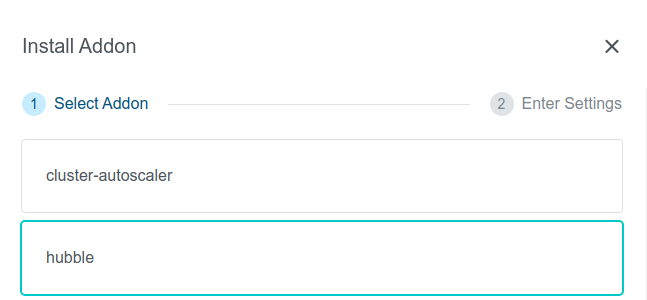
After the Hubble addon is installed into the cluster, the Hubble UI can be displayed by port-forwarding to it, e.g.:
kubectl port-forward -n kube-system svc/hubble-ui 12000:80
After the above port-forwarding is active, the Hubble UI can be shown by navigating to the URL http://localhost:12000.
Please note that to have the Hubble addon available, the KKP installation has to be configured with hubble as an accessible addon.
None CNI
“None” CNI is a special KKP-internal CNI type, which does not install any CNI managed by KKP into the user cluster. CNI management is therefore left on the cluster admin which provides a flexible option to install any CNI with any specific configuration.
When this option is selected, the user cluster will be left without any CNI, and will not be functioning until some CNI is installed into it by the cluster admin. This can be done either manually (e.g. via helm charts), or by leveraging KKP Addons infrastructure and creating a custom Accessible addon.
CNI Version Upgrades
If the KKP installation supports a newer version of the CNI installed in a user cluster, it is possible to upgrade to it. This will be shown in the KKP UI and the available versions will be listed in the upgrade dialog shown after clicking on the “CNI Plugin Version” box:


Once a newer version is selected, the CNI upgrade in the user cluster can be triggered by clicking on the “Change CNI Version” button. Please note that this action may cause network connectivity drops in the cluster, so it should be performed during a maintenance window.
Generally, only one minor version difference is allowed for each CNI upgrade. There are two exceptions to this rule:
- If the cluster is labeled with the
unsafe-cni-upgradelabel (e.g.unsafe-cni-upgrade: "true"), any CNI version change is allowed. In this case, users are fully responsible for the consequences that this upgrade may cause and KKP is not putting any guarantees on the upgrade process. - When upgrading from an already deprecated version, the upgrade is allowed to any higher version. Please double-check that everything is working fine in the user cluster after such upgrade. Also please note that it is not a good practice to keep the clusters on an old CNI version and try to upgrade as soon as new CNI version is available next time.
Forced CNI Upgrade
Some newer Kubernetes versions may not be compatible with already deprecated CNI versions. In such case, CNI may be forcefully upgraded together with Kubernetes version upgrade of the user cluster. The following table summarizes the cases when this will happen:
| Kubernetes Version | CNI | Old CNI Version | Version After K8s Upgrade |
|---|---|---|---|
>= 1.22 | Canal | v3.8 | latest supported Canal version |
Again, please note that it is not a good practice to keep the clusters on an old CNI version and try to upgrade as soon as new CNI version is available next time.
Konnectivity
Konnectivity provides TCP level proxy for the control plane (seed cluster) to worker nodes (user cluster) communication. It is based on the upstream apiserver-network-proxy project and is aimed to be the replacement of the older KKP-specific solution based on OpenVPN and network address translation. Since the old solution was facing several limitations, it will be replaced with Konnectivity in future KKP releases.
Enabling Konnectivity in KubermaticConfiguration
To enable Konnectivity for control plane to worker nodes communication, the feature first has to be enabled in KubermaticConfiguration by enabling the KonnectivityService feature gate, e.g.:
apiVersion: operator.kubermatic.io/v1alpha1
kind: KubermaticConfiguration
metadata:
name: kubermatic
namespace: kubermatic
spec:
featureGates:
KonnectivityService:
enabled: true
All existing clusters started before enabling KonnectivityService feature gate will continue using OpenVPN.
Enabling Konnectivity for New Clusters
Once the KonnectivityService feature gate is enabled, Konnectivity can be enabled on per-user-cluster basis. When creating a new user cluster, the Konnectivity checkbox will become available in the Network Configuration part of the cluster in the KKP UI (and will be enabled by default):
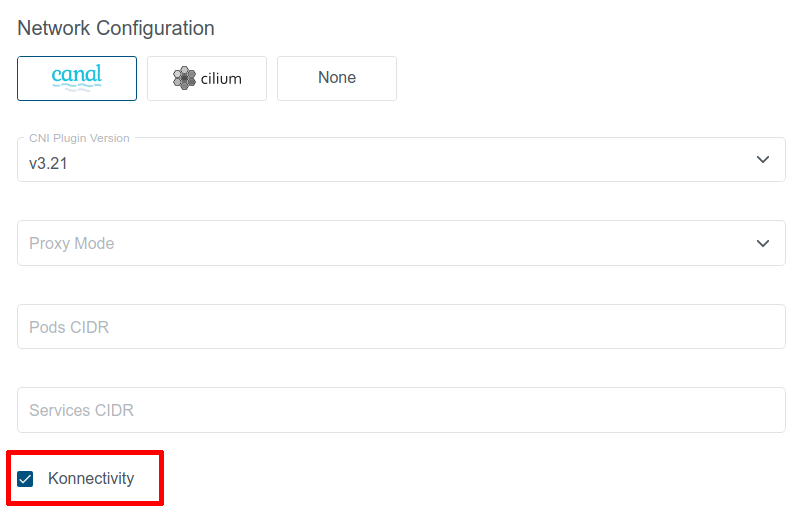
When this option is checked, Konnectivity will be used for control plane to worker nodes communication in the cluster. Otherwise, the old OpenVPN solution will be used.
Switching Existing Clusters to Konnectivity
Given that the KonnectivityService feature gate is enabled, existing user clusters that are using OpenVPN can be migrated to Konnectivity at any time via the “Edit Cluster” dialog in KKP UI:
This action will cause a restart of most of the control plane components and result in temporary cluster unavailability, so it should be performed during a maintenance window.
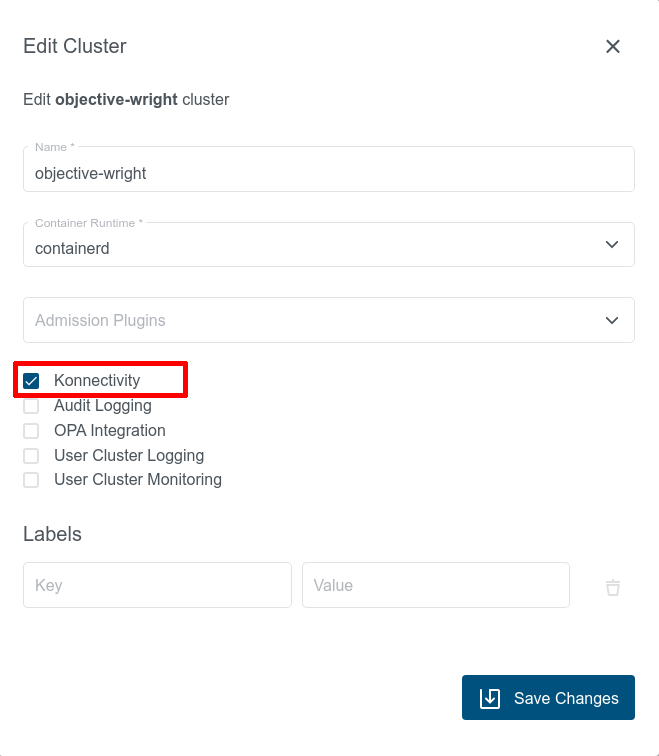
After switching to Konnectivity, give the control plane components in Seed enough time to redeploy (may take several minutes). Once this redeployment is done, you should see two konnectivity-agent replicas running in the user cluster instead of the openvpn-client pod. Apart from it, you should also see new metrics-server pods running in the user cluster:
$ kubectl get pods -n kube-system
NAMESPACE NAME READY STATUS RESTARTS AGE
kube-system konnectivity-agent-c5f76c89f-8mxvt 1/1 Running 0 6m35s
kube-system konnectivity-agent-c5f76c89f-hhdmq 1/1 Running 0 6m35s
kube-system metrics-server-59566cbd5c-crtln 1/1 Running 0 6m35s
kube-system metrics-server-59566cbd5c-lw75t 1/1 Running 0 6m35s
This action can be also reverted and an existing user cluster using Konnectivity can be switched back to the OpenVPN-based solution if necessary.
Other Cluster Network Configuration
Apart from the above mentioned ones, there are several other networking parameters that can be configured for the user cluster from the KKP UI:
Proxy Mode: configures kube-proxy mode for k8s services. Can be set toipvs,iptablesorebpf(ebpfis available only if Cilium CNI is selected and Konnectivity is enabled). Defaults toipvs.Pods CIDR: The network range from which POD networks are allocated. Defaults to[172.25.0.0/16]([172.26.0.0/16]for Kubevirt clusters).Services CIDR: The network range from which service VIPs are allocated. Defaults to[10.240.16.0/20]([10.241.0.0/20]for Kubevirt).
Cluster Cluster Network Configuration in KKP API
All of the settings described in the previous sections (plus some more) can be also configured via KKP API endpoint for managing clusters:
/api/v2/projects/{project_id}/clusters/{cluster_id}
The CNI type and version can be configured in spec.cniPlugin.type and spec.cniPlugin.version.
The other networking parameters are configurable in spec.clusterNetwork.
When no explicit value for a setting is provided, the default value is applied. The following table summarizes the parameters configurable via the KKP UI / spec.clusterNetwork in the cluster API with their default values:
| Parameter | Default Value | Description |
|---|---|---|
proxyMode | ipvs | kube-proxy mode (ipvs/ iptables / ebpf). ebpf is allowed only if Cilium CNI is selected and Konnectivity is enabled). |
pods.cidrBlocks | [172.25.0.0/16] ([172.26.0.0/16] for Kubevirt) | The network ranges from which POD networks are allocated. |
services.cidrBlocks | [10.240.16.0/20] ([10.241.0.0/20] for Kubevirt) | The network ranges from which service VIPs are allocated. |
dnsDomain | cluster.local | Domain name for k8s services. |
ipvs.strictArp | true for ipvs proxyMode, false otherwise | If enabled, configures arp_ignore and arp_announce kernel parameters to avoid answering ARP queries from kube-ipvs0 interface. |
nodeLocalDNSCacheEnabled | true | Enables NodeLocal DNS Cache feature. |
konnectivityEnabled | false | Enables Konnectivity for control plane to node network communication. Requires KonnectivityService feature gate in the KubermaticConfiguration to be enabled. |